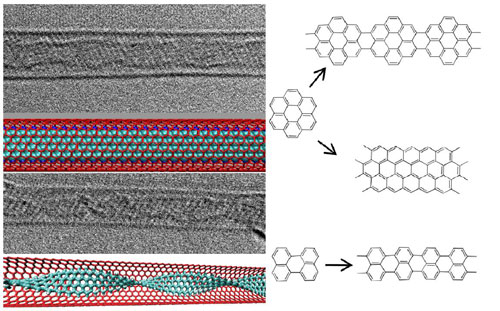| Sep 21, 2011 |
New hybrid carbon nanomaterial synthesized
|
|
(Nanowerk News) A nnovel hybrid carbon material, which combines both graphene and SWNTs, Graphene Nanoribbons encapsulated into Single-Walled Carbon Nanotubes (GNR@SWNTs) have been discovered by researchers from Aalto University (Finland) and Umea University ("Synthesis of Graphene Nanoribbons Encapsulated in Single-Walled Carbon Nanotubes").
|
|
Carbon nanotubes and graphene materials have attracted enormous interest from a broad range of specialists.
|
|
"We came up with the idea to create a novel hybrid material, which combines two most fascinating carbon nanomaterials - single-walled carbon nanotubes and grapheme," says Doctor Albert Nasibulin from Aalto University.
|
 |
| Formation of the GNR is possible due to confinement effects provided by the one-dimensional space inside nanotubes, which helps to align coronene or perylene molecules edge to edge to achieve dimerization and oligomerization of the molecules into long nanoribbons. Almost 100% filling of SWNT with GNR is achieved while nanoribbon length is limited only by the length of the encapsulating nanotube. The PAH fusion reaction provides a very simple and easily scalable method to synthesize GNR@SWNT in macroscopic amounts. First-principle simulations indicate that encapsulation of the GNRs is energetically favorable and that the electronic structure of the encapsulated GNRs is the same as for the free-standing ones, pointing to possible applications of the GNR@SWNT structures in photonics and nanoelectronics.
|
|
SWNTs have a hollow space inside, which was used in this study as an 1-dimensional chemical reactor. An intriguing property of this space is that chemical reactions occur differently compared to the bulk 3D conditions. Large polyaromatic hydrocarbon molecules (coronene and perylene), which can be imagined as small pieces of graphene, were used as building blocks to produce long and narrow graphene nanoribbons inside the nanotubes.
|
|
It was found that the shape of encapsulated graphene nanoribbons can be modified by using different kinds of polyaromatic hydrocarbon molecules. Nanoribbons can be either metallic or semiconductor depending on their width and type. Interestingly, SWNTs can also be metallic, semiconducting (depending on their chirality) or insulating when chemically modified.
|
|
This creates enormous potential for a wide range of applications: Now we can prepare GNR@SWNT in all possible combinations. For example, metallic nanoribbon inside insulating nanotube can be considered as the thinnest insulated nanowire. Nanoribbons can be used directly inside of SWNTs to generate light (e.g. as light emitting diodes), which will easily go through nanotubes and GNRs and by using of existing energy barrier will became a nano-lamp. Semiconducting nanoribbons can be used for transistor or solar cell applications. Metalli-metallic combination is in fact a new kind of coaxial nanocables (widely used as transmitters of radio signals) in nanosize since the nanoribbons are not connected with nanotubes due to hydrogen atoms, which occupy all the edges of nanoribbons.
|
|
"Precise control of the width and angle of the graphene nanoribbons will help assembly materials based on graphene with strict control of the band gap. Such control is not possible for a macroscopic graphene, obtained by traditional technology," says Dr. Ilya Anoshkin.
|
|
The method of GNR@SWNT synthesis is very simple, easily scalable and allows to obtain almost 100% filling of tubes with nanoribbons. As it follows from theoretical results included in the paper, graphene nanoribbons should keep their unique properties inside of nanotubes while protected from environment by encapsulation and aligned within bundles of SWNTs.
|

